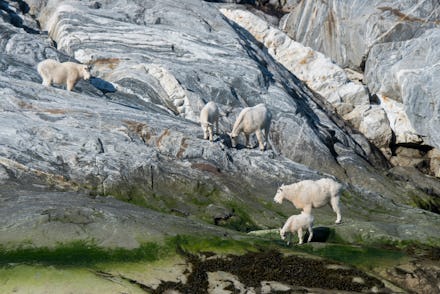Glacier National Park’s mountain goats could go extinct, thanks to climate change

The mountain goats in Glacier National Park are in trouble. A new study, released yesterday, has found that the North American mountain goats in Glacier National Park use patches of snow to cool themselves down during the summer. It's a neat trick, but there's a problem: Glacier National Park has lost 75 percent of its glaciers and is losing more patches of snow largely due to climate change. This means, if the snow continues to disappear, the goats could be struggling with overheating in the future. In a worst-case scenario, their population could begin dying out.
Extinction might sound like a really extreme result, but it's something that's happened before. Wesley Sarmento, co-author of the study and a researcher from the University of Montana, noted that a similar warming event that occurred way back in North America's history could be a sign of what people might see with the mountain goats in Glacier National Park.
"10,000 years ago, when the North American climate was cooler, there were mountain goats in Grand Canyon," he said, "but certainly increasing temperatures and drier weather ultimately contributed to their extinction in that area."
Both people and animals seek shade and cooler areas to get away from the heat. But mountain goats live in a unique environment, the rocky areas that are typically above the treeline, that have fewer places to stay cool. The authors found that what little shade there might be didn't do much to help the goats cool down, either. Resting in patches of snow, on the other hand, reduced their breathing rates by as much as 15 percent, resulting in less heat stress for the animals.
As long as climate change continues to rapidly heat the Earth, the mountain goats will have to adapt and figure out an alternative way to stay cool. It's something many species will need to do as the environment alters.
"This work is important to shed light on the impacts of a changing climate on these iconic animals and their habitat," said co-author Mark Biel of Glacier National Park. "How certain species may adapt as the changes continue is critical in understanding their persistence on the landscape into the future."
The signs of animals struggling with cooling themselves isn't just a concern for wildlife conservationists. It's also a concern for humans. Co-author Joel Berger, from the Wildlife Conservation Society, pointed to the summer heatwaves in Europe as an example. This year, summer temperatures broke records in numerous countries and prompted warnings about health risks from heat exposure.
"Just as people are feeling the heat of a warming planet with thousands and thousands struggling during summer without natural cooling systems, we're seeing very clearly that what happens to people is also happening to animals," Berger stated, "we're all in this together."